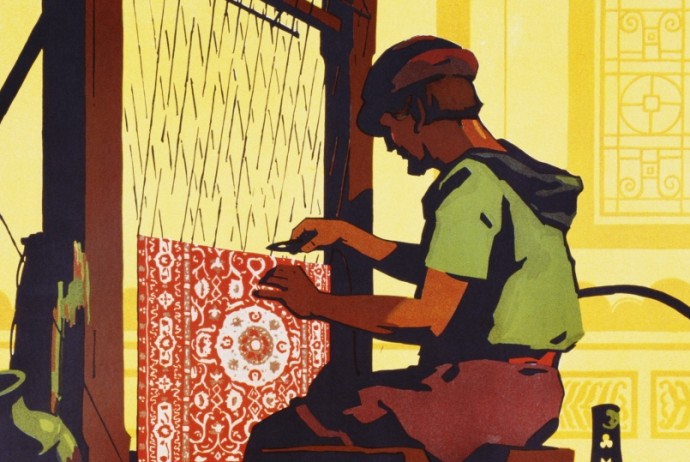The Textile Industry
By: Kayla Chappell
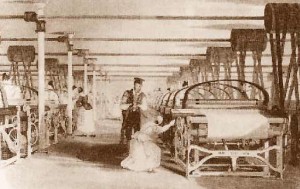
Textile Mill
by Unknown, used under 
The rise of Industrialism in Europe in the 18th century set the stage for major advancements. Advancement made in different sectors of society paved the way for even more advancements in other industries. The textile industry became more prominent during the Industrial Revolution due to development and progression of transportation. Goods could be transported faster than ever before. In addition, innovation resulted in significant evolution of machinery. This ultimately led to increased demand in goods and allowed room for growth and profit in the textile industry. The textile industry was said to be “the most advanced, mechanized, and factory-based” (O’brien, 1991) British industry during the industrial revolution. One of the major realizations in textiles during the industrial revolution was that of the revolutionary cotton crop.
Cotton:
Cotton was a major cash crop that helped propel the textile industry during the industrial revolution, particularly in Britain. Before industrialism, wool was the most commonly used material for fabric. Wool came from the livestock of the rural farmers. It was a sturdy material that could be woven into clothing and other goods by use of a large loom. The original wool weaving looms were large and difficult to maneuver, thus men were the main laborers in the textile industry at the time. Spinning wheels were also common place before the rise of the cotton industry.
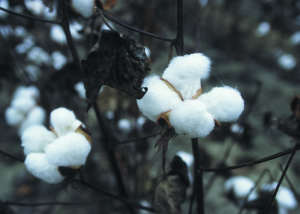
Cotton Plant
by USDA photographer, USDA Natural Resources Conservation Service, used under 
Cotton was a much finer fabric than wool and was more desirable among the people during the industrial revolution. In the 16th century and the years leading up to the industrial revolution in Europe, India was the main exporter of cotton. To maintain power and a balanced economy, the government restricted imports of cotton products. In turn, the demand for cotton products increased. This resulted in a widespread movement of innovation in textile machinery. It was noted that “everything of importance [in regards to the cotton industry] began with the invention of the spinning machines in the 1760’s” (O’brien, 1991) and further advancements in textile machines allowed the cotton industry to soar. New techniques were discovered that created a higher quality of cotton fabric and an easier, less physically demanding way to utilize it. As society began steering away from the rural producers, it began favoring the construction of cotton mills that were “constructed using the latest technology,” such as steam engine-powered looms (Burchill, 2013) which allowed mass production of cotton goods to become reality. The new technology allowed cotton products to be produced, distributed, and sold faster and to a larger area.
Technology Timeline:
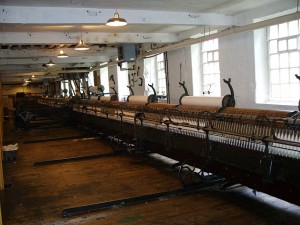
Mule Spinning Machine
by Black Stripe, used under 
1733: The Flying Shuttle – John Kay
1764: The Spinning Jenny – James Hargreaves
1769: The Water Frame – Richard Arkwright
1779: The Spinning Mule – Samuel Crompton
1785: The Power Loom – Edmund Cartwright
The Flying Shuttle:
The Flying Shuttle was invented by John Kay in 1733 and was the first industrial tool that made significant progressions in the textile industry. The Flying Shuttle allowed thread to be woven on a much larger scale and at a much faster rate. It also halved the time and labor costs of the industry (Burchill, 2013). Overall this led to more improved weaving techniques.

The Flying Shuttle
by Audrius Meskauskas, used under 
The Spinning Jenny:
The Spinning Jenny was created in 1764 by James Hargreaves. The earlier textile technologies allowed only one strand of thread to be woven at any given moment. Hargreaves invention made it possible for eight threads to be woven at once, increasing the speed and output of weaving once again. The Spinning Jenny was also a smaller machine and therefore still relatively cheap to construct. The Spinning Jenny’s revolutionary integration into the industry decreased the need for textile laborers even more than with the implementation of the Flying Shuttle.
The Spinning Jenny was named after Hargreaves’s daughter (Burchill, 2013).
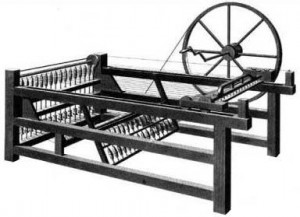
The Spinning Jenny
by Unknown, used under 
The Water Frame:
The Water Frame was developed in 1769 by Richard Arkwright and was the first piece of machinery large enough to encourage the construction of textile factories. It ran by watermill, which was most efficiently and effectively utilized by factories. The Water Frame transferred much of the textile industry from rural communities to larger industrial factories in the city and near large waterways. The Water Frame was a revolutionary instrument because it caused a mass movement of labor to the cities and allowed for mass production of textiles.
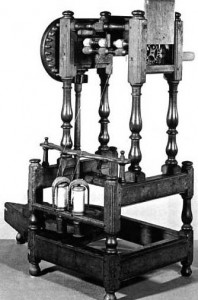
The Water Frame
by Unknown, used under 
The textile industry was a crucial sector of the revolutionary advancements made during the industrial revolution. The innovation in textile machinery and faster textile production encouraged the drive for efficiency in industry. Overall, it completely changed the definition of the labor force and structure of society and directly influenced the processes by which our goods are produced today.
For more information about the Industrial Revolution Click Here!
Citations:
Audrius Meskaukas. (n.d.). [Photograph of The Flying Shuttle].Retrieved from http://www.saburchill.com/history/chapters/IR/009.html under Public Domain License.
Black Stripe. (August 2007). [Photograph of A working Mule spinning machine at Quarry Bank Mill].Retrieved from http://history.parkfieldict.co.uk/victorians/victorian-cotton-mills under Creative Commons Attribution-Share Alike 3.0 Unported License.
Unknown Photogrpaher. (n.d.). [Photograph of The Spinning Jenny].Retrieved from http://www.saburchill.com/history/chapters/IR/010.htmll under Public Domain License.
Unknown Photographer. (n.d.). [Photograph of Textile Mill].Retrieved from http://www.saburchill.com/history/chapters/IR/014.html under Public Domain License.
Unknown Photogrpaher. (n.d.). [Photograph of The Water Frame].Retrieved from http://www.saburchill.com/history/chapters/IR/011.htmlunder Public Domain License.
USDA photogrpaher. (n.d.). [Photograph of Cotton Plant].Retrieved from http://history.parkfieldict.co.uk/victorians/victorian-cotton-mills under Public Domain License.
Martin, D. (1983, April). The Industrial Revolution: Toil & Technology in Britain & America. History Today, p. 24.
O’Brien, P. (1991, August). Political components of the industrial revolution: Parliametn and the English cotton textile industry, 1660-1774. Economic History Review, pp. 395-423.
Burchill, S. (2013). Brief History of the Cotton Industry. Retrieved March 28, 2014, from The Open Door Web Site: http://www.saburchill.com/history/chapters/IR/014.html
Burchill, S. (2013). The Flying Shuttle. Retrieved March 28, 2014, from The Open Door Web Site: http://www.saburchill.com/history/chapters/IR/009.html
Burchill, S. (2013). The Spinning Jenny. Retrieved March 28, 2014, from The Open Door Web Site: http://www.saburchill.com/history/chapters/IR/010.html
Burchill, S. (2013). The Water Frame. Retrieved March 28, 2014, from The Open Door Web Site: http://www.saburchill.com/history/chapters/IR/011.html
